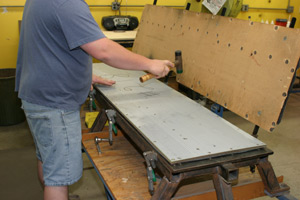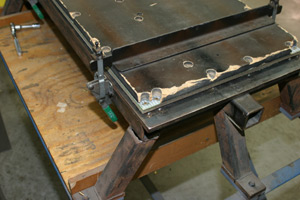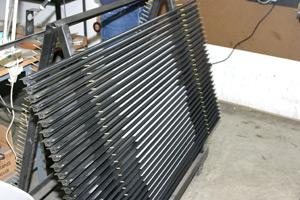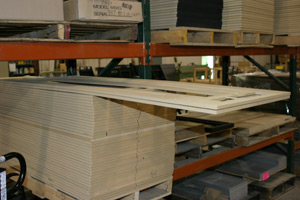"Those were my dad's," a voice from the corner says.
"Oh," I say. "Are you selling them?"
"You want them?" the voice asks.
"Maybe. How much?"
"We had them in here because we were going to box them up and throw them out." My mind fixates on the word "box."
"You have boxes for them?" I coyly ask.
"Yes, and they're bigger than the damn things."
"Well, I'm not sure they'll fit in my minivan, butI'll take them if the price is right. Boxes too." There is a pause whilethe voice ponders my offer.
"Ten bucks?"
I pause, then say "OK" in a calm tone.
The voice says, "I didn’t think anyone used dressing screens any longer."
"Yeah," I quip.
In case you didn't follow this waking dream, I justbought a pair of vintage Magnepan Tympani speakers with boxes for $10 --in my mind only, of course.. If I'm in an especially good mood fordaydreaming, I would see a pair of McIntosh tube monoblocks behind themwhen I load the speakers into my car.
But why be greedy, especially when something even better actuallyhappened: a semi pulled up in front of my house to deliver a pair ofMagnepan MG20.1s for review. The Tympanis were the top of the line intheir day, but the MG20.1s are the top of the line, period -- the bestspeaker that Jim Winey has ever designed. While they don't look muchdifferent from the MG3.6es, the MG20.1s are the most realized examplesof planar-magnetic/ribbon speaker technology that Magnepan has created.
Family resemblance
From the front, the MG3.6 and MG20.1 are nearlyimpossible to tell apart, but around back, the MG3.6's externalcrossover looks small next to that of the MG20.1, which spans the entirewidth of the speakers, the stands supporting its considerable weight.The crossover of both speakers is a target for DIYers the world over,who change parts or build new crossovers completely from scratch. Youcan biamp and biwire both speakers, and the MG20.1s are said to respondwell to use with an external crossover.

Beneath the acoustically transparent cloth are wherethe real innovations lurk. The MG3.6 uses a single planar-magneticmidrange/bass panel, while the MG20.1 uses a pair of slightly largerplanar-magnetic bass drivers. As a midrange, the MG20.1 has a version ofthe quasi-ribbon driver used as a tweeter in the MG1.6. Two of theserun alongside the planar-magnetic bass drivers. The four bass andmidrange drivers are then sandwiched between a pair of CNC-routed MDFframes. All other Magnepan speakers use a one-piece frame. In a loosesense, you can think of each MG20.1 as a pair of pimped-out MG3.6es along with a pair of quasi-ribbon midrange drivers.
The MG20.1 and MG3.6 use the same tweeter -- samesize, same materials, same everything. It is arguably the MG20.1's mostextraordinary feature. Magnepan builds each of these drivers by hand attheir factory. Outsourcing is impossible; there are too many fine pointsto the creation of this tweeter -- the corrugation done with aspecially built apparatus, the strategic placement of dabs of adhesiveto allow the ribbon to flex. A metal strip held in place by the driver'smagnets protects each tweeter during shipping; even small bursts of aircan snap the ribbon. (This is why you should never vacuum yourMG3.6es or MG20.1s.) In order to persuade a company to create thespecial material used for the ribbon, Magnepan had to buy literally alifetime supply. Each 2.5-micron-thick piece (2.5 x 10-6 or2.5 x one one-millionth of a meter) is cut to width and length by hand,obviously delicate work. One of the special razor blades used can cutonly a single piece of ribbon before it is too dull.
| 
How to make MG20.1s. Start with a rack of midrange/woofer panels.
| 
Take a pair of them...
|

...and bolt them together... | 
...in a specially made jig. |
| 
Add a ribbon tweeter...
| 
...and sandwich everything between two MDF frame pieces.
|
Assembly required
Here is another fantasy: When the pair of MG20.1sarrives, I only have to wrest them from their shipping boxes and theyare ready to play music. In reality, I have a better chance of finding apair of $10 Tympanis.
Only the Wilson Audio Alexandria X-2 requires moretime and effort to set up than the MG20.1. First, the MG20.1s are bigand heavy, and thus difficult to move: 79"H x 29"W x 1 5/8D and roughly140 pounds each. "A pair of barn doors," as one person referred to them.Magnepan includes knobs that screw into inserts on the back of thespeakers. They make lugging the MG20.1s around easier, and should beremoved after the speakers have been placed. Good thing -- theirutilitarian look seems out of place on high-end loudspeakers. They wouldlook right fine on barn doors, however.
Once you have become accustomed to the size and heftof the MG20.1s, you are ready to mount their stands, crossovers andribbon tweeters -- in that order. The T-shaped stands screw intopre-drilled holes in the speaker's frame. This is easy enough if youhave a helper, and a bit more difficult if you don't. The stands arealso the supports for the large crossovers, which attach electrically tothe speakers via gold-plated rods. This takes some time because of allthe Allen screws to loosen and tighten on the speaker and crossover, butat least you can do it with the speaker upright.
Each MG20.1 ships without its tweeter installed inorder to protect the ribbon from shipping damage. Each tweeter is heldin place with 25 screws. A cordless drill may strip their holes, so all50 screws have to be driven in by hand. This takes quite a bit of time.
Or so I would guess. The speakers I received forreview were a pair of Jim Winey's that were borrowed while he was away.Magnepan mistakenly left the tweeters installed, but they arrivedwithout damage. Even so, unpacking and assembling the speakers took methree hours; I suspect tweeter installation would have added anotherhour.
The universal truths of setup
Positioning the MG20.1s is more painstaking work thanassembling them. Because of their height, width and dipole radiation(in-phase sound from the front, out-of-phase sound from the rear), theMG20.1s are especially tricky to set up. I remember talking with WarrenGehl, ARC's in-house listener, right before the speakers arrived. "Youhave an assignment, " Warren said to me. "You have to discovereverything great about the 20.1s and write about it." Well, Warren, thefirst step on this road of discovery is positioning the speakersoptimally. Perhaps this is no news, but setup is a greater challengewith the MG20.1s than 99.9% of the speakers on the market.
Through much trial, error, and more trial, I foundsome very sweet spots for the MG20.1s in my large 20'W x 29'L x 10'Hroom. What I took from this process was not any sort of magical Maggieplacement ratio, but instead the importance of a couple of things thatshould be relevant in other rooms -- and may be the keys to completingWarren's assignment.
First, the listening position is an integral part ofsetting up these speakers -- more so than with most other speakers.Maybe this seems obvious, but in our quest to determine how far eachspeaker should be from the walls around it, we often forget that ourears are part of the sonic equation as well. After moving the speakersand my listening couch around the room, I came upon the first importanttruth: Sit as close to the MG20.1s as possible and preferably no fartheraway than the speakers are apart. As dipoles, the speakers excite myroom to a degree that no other speaker has. Sitting closer meant that Iwas hearing more of the speakers and less of their reflections and theroom itself.
Another truth may be more a matter of taste thanuniversal applicability, given the different dimensions and uses ofevery room: Move the speakers as far apart as possible, but not so farapart as to skew the distance to the listening seat. I could seeminglymove the MG20.1s away from each other as far as my room would allow --from wall to wall -- and still hear a solid center image. Yes, thesoundstage grew wider, but reflections also became more audible,smearing the sound to an obvious degree. There is a point at whicheverything aligns -- speaker positions, room, and listening position --and, in your room, it may mean that the speakers are closer togetherthan you may like given their size, or that you're sitting closer to thespeakers than you are accustomed. Unlearn habit and preference to getthe most out of the MG20.1s, Grasshopper. You will probably not be ableto put them where you had your previous speakers and hear them at theirbest.
The final issue to consider is an eternal one: innieor outie? That is, do you position the ribbon tweeters on the inside oroutside edge of the speakers? Magnepan gives some pointed information inthe MG20.1's manual:
"Room acoustics and your own personal tastes willdetermine whether to position the panels with the tweeters on the insideor outside edge. In most rooms, placing them on the outside will givegood dimensionality. Placing them on the inside will, in most cases,increase the central focus and improve imaging."
What I found is different and has to do only withintegration. No matter the speakers' positions or toe-in, I could hearthe tweeters apart from the rest of the sound when they were on theoutside, but I couldn't detect them when they were on the inside. Weredimensionality, central focus and imaging affected by tweeter position?Maybe, but I couldn't hear past the sense that the highs seemed to haveexaggerated width because the tweeters were as far apart as possible.Therefore, the third truth I discovered was to place the tweeters on theinside; however, I will concede that in a narrow room where thespeakers are closer together, outside placement may create a wider, morelifelike soundstage. As Yoda would counsel, "Varied may your mileagebe."
"Everything great about the 20.1s…"
In my "$10 Tympani" fantasy, I get the speakers home,figure out how to set up six panels in my room, and what I hear is…thesound of the MG20.1s. What is that? Create your own fantasy, or checkthis space on September 1.
...Marc Mickelson
marc@soundstage.com
Magnepan MG20.1 Loudspeakers
Price: $12,500 USD per pair.
Warranty: Three years parts and labor. Magnepan
1645 Ninth Street
White Bear, MN 55110
Phone: (800) 474-1646 Website: www.magnepan.com |